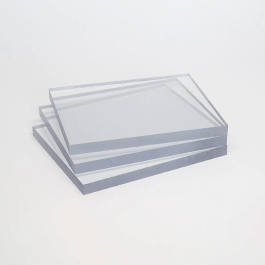Material Overview of Polycarbonate

What is Polycarbonate (PC)?
Polycarbonate is an amorphous, transparent thermoplastic known for its outstanding strength, stiffness, and impact resistance. It makes an excellent alternative to glass as it is lightweight, possesses a natural UV filter, and promotes the internal transmission of light almost as effectively as glass. Polycarbonate is easy to machine and thermoform, making it ideal for a variety of applications.
Key Properties
- High impact strength
- High modulus of elasticity
- Excellent electrical insulation properties
- Low coefficient of thermal expansion
- High modulus of elasticity
- Optimal creep and cold flow resistance
- High tensile strength
What is Polycarbonate Used For?
Polycarbonate is utilized in a number of applications for its light weight, flexibility, and high strength. The use of this plastic is popular for glasses, luggage, windshields, prototyping, vehicle headlights, lighting fixtures, and much more. Additionally, its transparency allows it to be a functional replacement for a wide range of materials.
Other uses include:
- Greenhouses
- Roofing panels
- Windows
- Sports equipment
- Lenses
- Phone and computer cases
- Machine guards
- Safety glasses
 Polycarbonate greenhouse
Polycarbonate greenhouse
Finished Polycarbonate
- Polycarbonate Sheets - Exhibit glass-like characteristics but at half the weight and have much better impact resistance. It is easy to thermoform and bonds well with adhesives and solvents. They are ideal for roofing and are often used in greenhouses or as windows.
- Polycarbonate Rods - Offer good machinability and electrical properties. It is typically used for safety engineering and vehicle construction.
- Polycarbonate Tubes - Great for a range of products such as glasses, medical devices, electronics packaging, and LED tubing.
Types of Polycarbonate
In the modern era of manufacturing, companies compete for business by creating unique formulations and variations of materials like polycarbonate. Commonly referred to by some of its popular trade names Lexan®, Makrolon®, or Tuffak®, polycarbonate has seen many adaptations to target specific uses. Here are a few coatings FixSupply offers to enhance the performance of polycarbonate sheets:
- Colored Polycarbonate: Semi-clear and opaque colored sheets are well suited for signs and containers. Explore colors including black, white, bronze, and gray.
- Scratch & UV Resistant Polycarbonate: Has a clear hard coating that provides protection against abrasion, chemicals, sunlight, and weather.
- Antistatic Polycarbonate: Antistatic protective coating prevents the buildup of static charges and protects sensitive equipment from damage.
- Bullet-Resistant Polycarbonate: Has an extremely high resistance that does not shatter, even when exposed to violent impact. These sheets meet UL 752 ballistic standards for bullet resistance.
Why is Polycarbonate Popular?
While it stands out for its durability, weatherability, transparency, and flexibility, polycarbonate features other strong characteristics that can be utilized in a number of industries. PC is considerably less toxic than many other plastics and is available BPA-free for applications involving food and drink.
As a thermoplastic, polycarbonate is easily melted down to be recycled and reused. It serves as an environmentally conscious alternative to other plastics. Lastly, PC has excellent heat resistance and can be combined with flame-retardant materials without significant material degradation.
Polycarbonate vs. Acrylic
When it comes to clear plastics, acrylic and polycarbonate are often considered in the same conversation as an alternative. Compared to glass, both are half the weight, exponentially stronger, and offer excellent flexibility. This, however, is where their similarities come to an end. In a comparison of acrylic and polycarbonate sheets, here is how they match up.
|
Polycarbonate |
Acrylic |
|
|
Advantages |
|
|
|
Disadvantages |
|
|
|
Common Applications |
|
|
When to Use Polycarbonate and Acrylic
In general, acrylic is good for applications where high-impact resistance is not needed. This includes glass window substitutes, retail displays, and craft projects. On the other hand, polycarbonate is chosen for heavy-duty applications, such as bullet-proof glass, machine guards, equipment windows, and security glazing. It is also used for casting projects due to its high heat resistance.
Contact Us
For more information or inquiries about polycarbonate products, please contact us at 888-839-0681 or service@fixsupply.com.

